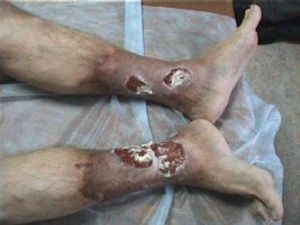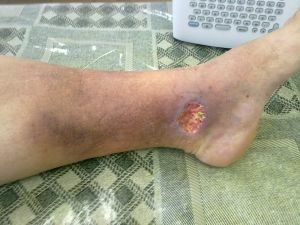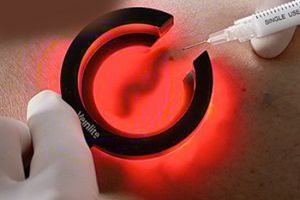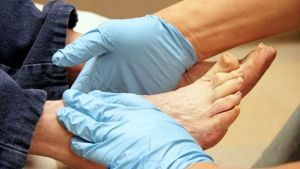 Trophic ulcer is a disease that most often occurs in people of retirement age. However, this illness and youth will not pass, most often hitting the patient's legs.
Trophic ulcer is a disease that most often occurs in people of retirement age. However, this illness and youth will not pass, most often hitting the patient's legs.
Trophic ulcer is a long-lasting non-healing wound, most often formed on the legs, associated with a disruption of the supply of tissues( blood supply).
Before the appearance of an ulcer, there is always a "preparatory" stage. It lasts for years in the body in humans, and is associated with changes in the vessels.
Initially, there is swelling, leaving only in the morning. Then small small veins appear on the surface of the skin, further large, enlarged venous nodes appear, then pigmented spots of blue color.
The skin becomes thin and, in the end result, a trophic ulcer occurs.
Content
- causes of illness
- diseases that provoke ulcer
- Additional causes illness
- symptoms and signs of illness
- Classification
- Stages ulcer development
- Diagnostics
- Therapeutic measures
- Conservative treatment
- Topical treatment of the disease
- When and why prescribed surgery
- Ozone
- Argosulfan
- Complications and risk of amputation
- Prevention
- Video: How to treat trophic ulcers on the legs
Reasonsoccurrence of disease
Causes of ulcers are very diverse. Most often, the causes of the disease include a long-term process of varicose veins ( venous vein disease), post thrombotic disease( a disease that developed after deep vein thrombosis).
Diseases that provoke the ulcer
The trophic ulcer often becomes a consequence of diseases.
Varicose veins gradually lead to trophic changes in the skin, most often in the ankle joint. Expanded veins, disrupt blood circulation, clots are formed, which affect the appearance of purulent foci.
Additional causes of the disease
Not all people with varicose veins have trophic ulcers. For the appearance of ulcers, there must be some other mechanism, acting from the outside, which accompanies the development of the ulcer.
To such causes of trophic ulcers on the legs can be attributed:
- excess weight;
- diabetes mellitus;
- atherosclerosis of the vessels of the lower limbs;
- extensive traumatic skin lesions;
- burns and frostbite;
- disease of the liver, biliary tract, gynecological diseases, intestinal diseases.
However, most often, the ulcer appears due to the person himself, when he does not follow the doctor's basic recommendations for the treatment of any of the listed diseases.
Symptoms and signs of a disease
As a rule, the symptoms of a trophic ulcer on the leg largely duplicate the symptoms of an ailment that provokes it, but there are also some peculiarities. 
Symptoms and signs, characterizing the further appearance of ulcers , can be attributed, according to increasing, pain in the legs, night cramps, puffiness, not passing in the morning, the appearance of "bluish" spots on the legs, accompanied by burning, the appearance of ulcers.
If after six to eight weeks there is no scarring of the wound that appears, you can safely talk about the appearance of trophic ulcers.
Classification of
If you understand the cause of trophic ulceration, you can make the following classification:
- vascular( those ulcers that are caused by venous diseases( varicosity, thrombosis, thrombophlebitis) or arterial diseases;
- caused by diseases( diabetes, hypertension, kidney, liver, bowel disease);
- infectious( eg syphilis);
- traumatic(bites of animals, insects, etc.);
- caused by burns with chemicals( acid, alkali, etc.);
- caused by natural factors( burn, frostbite, etc.);
- caused by neglected skin diseases(eczema, d___
- caused by the formation of a new epidermis( papilloma);
- triggered by the action of various drugs( the administration of various substances, for example, drugs);
- circular ulcers( both on the inner and the surface side, up to the bone.) Appear on late terms of the disease.
Ulcers are of various forms: are oval or round. There may be one ulcer or several, combined into one.
Ulcer can be classified and depending on its size( it all depends on the area). The following are distinguished: small ulcer, medium, large, extensive.
 A good help to traditional medicine will be the treatment of trophic ulcers by folk remedies. Choose a good recipe you can in our article.
A good help to traditional medicine will be the treatment of trophic ulcers by folk remedies. Choose a good recipe you can in our article.A dangerous enemy of phlebotrombosis of deep veins should be diagnosed and eliminated on time. How to do it, find out here.
Stages of ulcer development
All vessels and veins cease to function properly, due to a violation of blood circulation. Most often, small vessels suffer. Then the disease covers larger veins, at the final stage - an ulcer appears. According to doctors, before ninety percent of ulcers are formed on the ankles of the legs .
One can single out four stages ulcer development:
- The first is due to the appearance and progression of the ulcer itself. Gradually, the living cells of the skin are near, the body tries to cope with the ulcer itself, to close it. There is a balance of the forces of destruction and the forces of recovery. So, there are purulent formations, and the body tries to "remove" the ulcer itself.
- Purulent formations - this is the second development stage.
- Scarring( removal of the body) ulcers - third .
- Restoring skin cells, covering young skin - this is the last, fourth stage.
Diagnostics
Treatment begins with a phased diagnosis, which includes the following activities.
First of all - visual diagnostics ( wound inspection).
Often the is diagnosed with vessels ( using ultrasound), blood tests( blood sugar detection) and urine tests are performed, and consults other specialists ( venereologist, cardiologist, gynecologist, etc.).
Healing measures
The treatment of this disease is very complicated and time-consuming. Treats such an ailment only specialist - dermatologist in cooperation with specialists in other fields. After ten to fifteen days of treatment, if there is no improvement, treatment should be repeated. Self-medication here is not acceptable.

The photo shows how the trophic ulcer on the leg is treated with a laser
. As a result of the diagnosis, a complex treatment program is prepared for the patient.
First of all it is dietetics .Use of products that inhibit the development of atherosclerosis and changes in blood vessels. It is necessary to exclude acute, fatty, salty foods, as well as alcohol.
Wear compression linen, selected by a specialist. Be sure to comply with strict hygiene. It is necessary to treat not only the ulcer itself, but also the whole system of ailments leading to it.
Conservative treatment
This treatment includes drug therapy in specialized departments of the clinics, aimed at cleansing the body, as well as washing and treatment of ulcers.
The complex of conservative treatment of trophic ulcers on the legs includes such directions:
- hirudotherapy( leeches) aimed at dissolving thrombi, improving blood circulation, cleaning the wound from pus;
- compression therapy( wearing compression linen, stocking, golf, pantyhose), normalizes blood outflow and helps inhibit the recurrence of ulcers;
- physiotherapy( physiotherapy, gymnastics);
- topical treatment( dressings, ointment application);
- electrostimulation improves circulation of fluids in tissues due to blood flow to the legs.
Also practiced intravenous, infusion therapy, intravenous laser irradiation, lymph drainage massage, magnetotherapy.
Local treatment of the disease
Doctors recommend using conservative treatment of trophic wounds, do not refuse from folk remedies for the treatment of trophic ulcers.
Very close to the place in this case phytotherapy ( various collections and herbs).They are aimed at healing ulcers and reducing pain. Compresses from sea buckthorn oil, fresh grated carrots, compresses( lotions) made of chestnut, chamomile, tomato and boiled potatoes, mackerel and sea buckthorn oil.
When and why surgical intervention is prescribed
When all methods of conservative treatment and results have already been tried, the ulcerative defect has not healed or the trophic ulcer is quite large, the last remedy is surgical intervention.
Plastic surgery is performed. They are in the transplantation of the damaged skin area. This method solves quite a lot of problems that are not available to traditional methods of treatment. So, the pain is already the next day after a skin transplant.
Ozone therapy
Ozone has a very good oxidizing property. As a result, they achieve high cleansing of the wound. Mikrotic tissues are removed. The site of ulcerative lesions is preliminarily prepared for plastic surgery.
External ozonotherapy is carried out with a course of five to ten procedures, well tolerated and combined with any kind of therapy.
Argosulfan
Cream with antibacterial action, in the form of a white homogeneous mass.
Treatment of trophic ulcers on the legs with this substance promotes rapid healing of wounds. 
It is prescribed in the treatment of trophic ulcers or preparation of the skin for plastic surgery.
It is used as an open method, and in the form of "gruel" for bandages.
Complications and Risk of Amputation
There are many subtleties in the treatment, and after the treatment of trophic ulcers.
If the treatment process is delayed and strong substances( tar, salicylic acid) are used, skin cancer can develop and develop. This can lead to amputation of the affected limb.
Prevention
Most often, trophic ulcers occur as a result of untreated varices .Therefore, the prevention of trophic ulcers on the feet includes, above all, the prevention of varicose veins and other diseases that provoke the appearance of ulcers.
Should rest the legs of , when visible symptoms( edema or venous asterisks) start to use ointments or gels. Do not forget about compression underwear, gymnastics and diet.
A special place when the first signs of a trophic disease appear, should be given the hygiene of the affected site .Often, the changes seen on the skin, getting the right treatment, quickly disappear. Complex treatment of the disease, as a rule, avoids the appearance of ulcers.
Trophic ulcers - are the constant companion of the neglected state of many ailments of skin and vessels. Planned complex therapy of such diseases, in most cases, blocks the appearance of ulcers. If the ulcer does begin to appear, you should consult a doctor without delay and start treatment.
